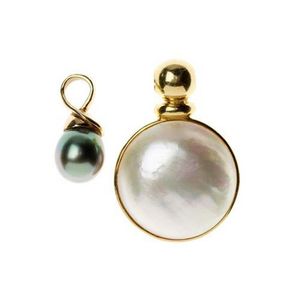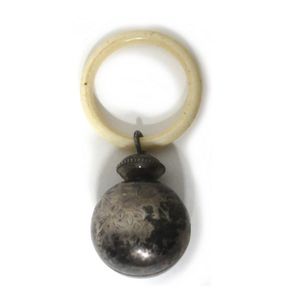Edwardian Silver and Ivory Baby Rattle and Teething Ring
An Edwardian silver and ivory baby's rattle and teething ring, a large rumble bell with floral engraved decoration suspended from ivory ring.
You must be a subscriber, and be logged in to view price and dealer details.
Subscribe Now to view actual auction price for this item
When you subscribe, you have the option of setting the currency in which to display prices to $Au, $US, $NZ or Stg.
This item has been sold, and the description, image and price are for reference purposes only.
- Edwardian - The Edwardian period of English furniture and decorative arts design is named for Edward VII (1841 ? 1910) who was King of the United Kingdom and the British Dominions and Emperor of India for the brief period from 1901 until his death in 1910. It follows the Victorian period, in turn was followed by the Art Nouveau and Art Deco styles. In Australia, designs of this period are also known as being in the Federation style.
- Ivory - Ivory is a hard white material that comes from the tusks of elephants, mammoth, walrus and boar, or from the teeth of hippopotamus and whales. The ivory from the African elephant is the most prized source of ivory. Although the mammoth is extinct, tusks are still being unearthed in Russia and offered for sale.
Ivory has been used since the earliest times as a material for sculpture of small items, both in Europe and the east, principally China and Japan.
In Asia ivory has been carved for netsuke, seals, okimono, card cases, fan supports, animals and other figures and even as carved tusks.
In the last 200 years in Europe ivory has been used to carve figures, for elaborate tankards, snuff boxes, cane handles, embroidery and sewing accessories, in jewellery and as inlay on furniture. Its more practical uses include being used for billiard balls, buttons, and a veneers on the top of piano keys.
The use and trade of elephant ivory have become controversial because they have contributed to Due to the decline in elephant populations because of the trade in ivory, the Asian elephant was placed on Appendix One of the Convention on International Trade in Endangered Species (CITES), in 1975, and in January 1990, the African elephant was similarly listed. Under Appendix One, international trade in Asian or African elephant ivory between member countries is forbidden. Unlike trade in elephant tusks, trade in mammoth tusks is legal.
Since the invention of plastics, there have been many attempts to create an artificial ivory
This item has been included into following indexes:
-
baby and child
- rattles 166
- teething rings 87
Visually similar items

Early gun metal sovereign case,
Sold by
in
for
You can display prices in $Au, $US, $NZ or Stg.

A Tahitian pearl and diamond pendant; 13.9 x 16 mm fine cultured pearl on an 18ct trefoil surmount set with single cut diamonds.
Sold by
in
for
You can display prices in $Au, $US, $NZ or Stg.

Carved ivory pendant, depicting Grecian maiden picking flowers by rock, singed on reverse MM, length including bale 75 mm.
Sold by
in
for
You can display prices in $Au, $US, $NZ or Stg.

Two gold and pearl pendants, 24 mm mabe pearl set in 18ct gold and a 10.3 mm round cultured Tahitian pearl in 9ct gold.
Sold by
in
for
You can display prices in $Au, $US, $NZ or Stg.
